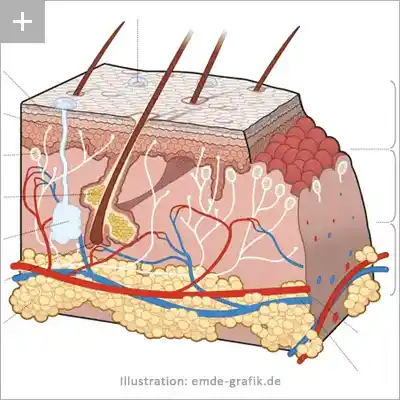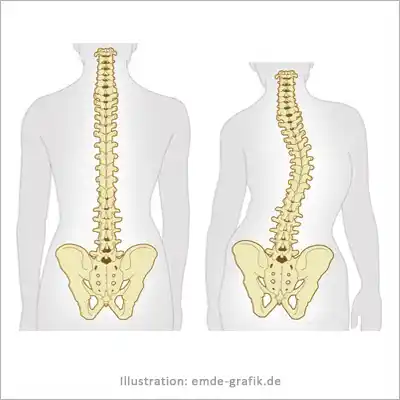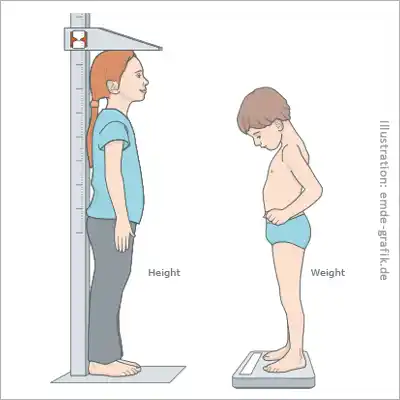Illustrations for successful medical publications, patient information, presentations, medical therapy, textbooks
Medical illustrations are always helpful and necessary, whether you are studying, working in medical research or as a practicing doctor, writing publications or wanting to provide patients with relevant material during treatment and the healing process. Attractive and comprehensible drawings are also indispensable in healthcare communication.

Medical illustration:
Ischemia
More about this project for the University Hospital of Tübingen

Illustration for dental training:
Nerves in the human jaw
More about this project for the State Dental Association of Hesse

Cross section of human skin / epidermis
Read more under „Featured projects“

Human knee: ligaments, muscles, tendons, bones

Individual instructions for patients with back complaints

Section through human shoulder:
For publication about the supraspinatus tendon

Illustration “Chronic lymphocytic Leukemia”
Information material for patients

Illustration scoliosis: Healthy and distorted spine
(in cooperatione with Georg Stelzner)

Shoulder joint prothesis – location of the implant

Usage of medical suture material – Variety of needles & threads depending on range of application in the body

Section through the human skull

Illustration for research work at a university hospital on the subject of lung disease

Liver, gall bladder, duodenum

Growth & growth disorders
Brochure for parents

Biological processes during puberty
Interaction of the gonads with the brain

Immune processes in the human skin
For publication about the evolution of the skin
Read more under „Featured projects“

Urological illustration of the ureter and bladder

Viral processes: Inhibitors
For publication about HIV
Frequently asked questions about medical illustrations (FAQ)
What is a medical illustration?
Anything that deals with medical topics. Very versatile, both thematically and stylistically: anatomy, drugs (principle of action, structure), microbiological processes, cellular research, virology, diagnostics (methodology, devices), materials (e.g. surgical suture material, knotting technique), patient information, publications, lectures.
What do I need medical illustrations for?
With different objectives (target group(s)), illustrations help to present the often complicated and possibly “unappetizing” topics in such a way that they are understood. For example, patient information: Good illustrations inform affected people, help them to understand and deal with illnesses and provide reassurance about upcoming operations or therapies.
What do I need to look out for in a medical information graphic?
First, know your target group. This will determine the style and structure of the graphics. Then: medical accuracy. As simple as possible, but do not over-simplify or above all else present incorrect data, just for the sake of comprehensibility. And last but not least: Appealing and aesthetic design. The graphics should also be a treat for the eyes, no matter what is being displayed.
What is the procedure for creating a visualization of health information?
It always starts with a detailed discussion. It has proven to be a good idea to start a project (especially if it is more complicated) with a telephone or video conference in which as many of the project participants as possible are present. This avoids misunderstandings, the team usually has good ideas during this process and the effort, coordination processes and timing can be planned very well.
Who are medicinal illustrations for?
Medical illustrations and information graphics are used in all areas of medicine. It is therefore important to know who the illustration is intended for: patient-doctor communication (brochures, information leaflets, explanatory booklets, explanatory animations, etc.), scientific publications, lectures, training courses for doctors or medical staff, children/young people, senior citizens, people with visual impairments (e.g. red-green deficiency or reduced visual acuity), people from other cultural backgrounds (languages, visual language, cultural taboos, etc.).
What does an illustration cost?
A medical illustration can consist of a simple little sketch or a highly complex interplay of multi-layered content, some of whose interactions are first worked out during or through the accompanying illustrative process. Prices therefore vary greatly. That’s why I always start with a very precise briefing in which I ask a lot of questions and then calculate an offer based on this.
In what form will I receive the illustrations?
That depends on the application you want as a customer. All common graphic formats (e.g. PNG, JPG, TIFF, PDF, EPS, SVG …) can be created and delivered without any problems. Multilingual versions or color or grayscale versions for print and screen applications are also possible.
